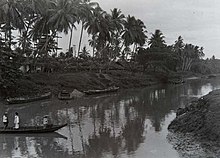|
Tan Liok Tiauw
Tan Liok Tiauw Sia (1872 - 1947) was a prominent Chinese-Indonesian landowner, planter and industrial pioneer in the late colonial period, best known today as the last Landheer (or landlord) of Batoe-Tjepper, now the district of Batuceper.[1][2][3][4] HistoryFamily backgroundBorn in Tangerang, Dutch East Indies in 1872, Tan hailed from a family of landlords and Chinese officers, part of the 'Cabang Atas' or the Chinese gentry of colonial Indonesia.[4] The Chinese officership was a high-ranking government position in the civil bureaucracy of the Dutch East Indies, consisting of the ranks of Majoor, Kapitein and Luitenant der Chinezen.[5] His father, Tan Tiang Po, served as Luitenant der Chinezen in Tangerang from 1877 until 1885, while his grandfather, Luitenant Tan Kang Soey, sat on the Chinese Council (Dutch: 'Chinese Raad'; Hokkien: 'Kong Koan') of Batavia or modern-day Jakarta, capital of Indonesia.[6][7][4] Tan's paternal great-grandfather was the tycoon Tan Leng (died in 1852), who was part of the powerful Ngo Ho Tjiang opium partnership.[8][9] Through his mother, Lim Hong Nio, Tan was a grandson of Lim Soe Keng Sia and Tan Bit Nio, as well as a great-grandson of Tan Eng Goan, the first Majoor der Chinezen of Batavia (1802-1872).[4] As a descendant of Chinese officers, Tan Liok Tiauw held the hereditary title of Sia from birth.[10] Tan's sister, Tan Him Nio, was married to Khouw Yauw Kie, Kapitein der Chinezen (died in 1908).[4] His daughter, Corry Tan Pouw Nio (1900-1961), was married in November 1917 to the prominent, half-Austrian, colonial politician Loa Sek Hie (1898-1965).[11][12][4] He also had two sons born to two different concubines: August Tan Tsjiang Kie and Jan Tan Tsjiang Bie.[4] Life  Tan grew up between his family's townhouse in downtown Batavia and their principal private domain, the particuliere landerij of Batoe-Tjepper, an agricultural estate in Tangerang.[12][1] He was given a traditional Chinese education, but also had a private Dutch tutor.[12] Tan's father, Luitenant Tan Tiang Po, retired from his role as Landheer in the late 1880s, and handed over the management of Batoe-Tjepper to his son.[4][1] Aged only 16, Tan Liok Tiauw not only improved the running of Batoe-Tjepper, but further developed an existing factory on the estate that manufactured building materials, roof-tiles and other terracotta products.[4][1] Many important colonial buildings in Java, in particular in Batavia, were built using materials from the factory.[13][14][15] In July 1923, Tan hosted Dirk Fock, the 30th Governor-General of the Dutch East Indies at Batoe-Tjepper as part of the latter's official visit to Tangerang.[16] Tan inherited other agricultural landholdings from his father on the latter's death in 1912.[17][18] Many of these estates were consolidated in the landholding firm N.V. Landbouw Maatschappij Tan Tiang Po, which was incorporated in 1899.[19] The company controlled the private domains of Rawa Buaya, Tanah Kodja, Pondok Kosambi, Minggoe Djawa and Kapoek, stretching from the western part of modern-day Jakarta to Tangerang.[2] A wide range of agricultural crops were cultivated on these landholdings: ranging from rice, coconut, other fruits and vegetables, and on to grass for animal feed.[2] Tan acquired a number of other business ventures. Together with the philanthropist O. G. Khouw (his brother-in-law's cousin) and D. N. van Stralendorff, he took over the tea and rubber estates of Tendjo Ayoe and Perbakti in the Preanger highlands in 1907.[20][21][22] These plantations were among the largest privately-owned estates in Sukabumi, and had been established in the 1870s by the tea pioneer B. B. J. Crone, an uncle of the Indo-Dutch writer E. du Perron.[23][24][25][26] As Director, Tan Liok Tiauw also headed N. V. Landbouw Maatschappij Tandjong West, a syndicate of landlords which purchased the old, eighteenth-century ‘particuliere land’ or estate of Tandjong West in 1917, today part of Jagakarsa in South Jakarta.[27][28] Beyond Java, Tan acquired Hacienda del Coco in Lampung on the southern tip of Sumatra, a formerly struggling British-owned plantation, founded by The Lampong Coconut Estates, Ltd.[29][30] These Sumatran estates grew coconut and pepper, and — like many of Tan's other landholdings — were run by professional European estate managers.[29] Tan died in 1947 in Batavia, was buried at his family's private burial grounds at Kebon Besar in Batoe-Tjepper, Tangerang.[4] References
|
||||||||||||||||